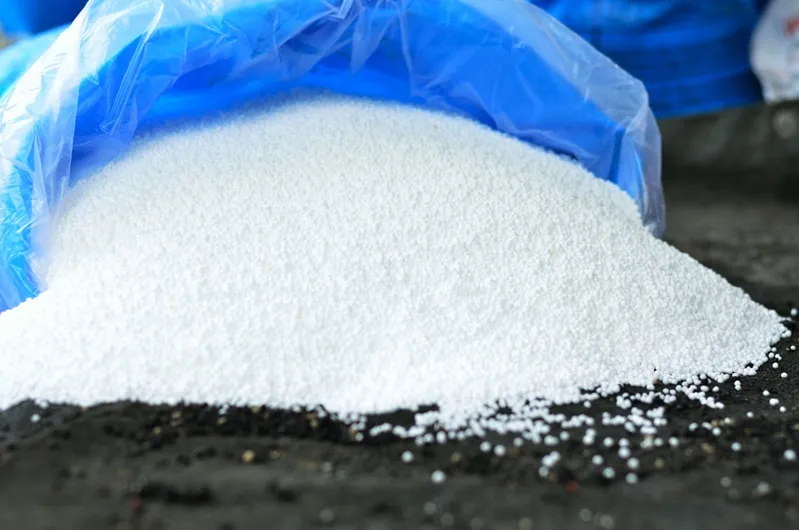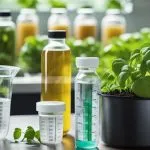Nitrogen is one of the most vital nutrients for plants grown in hydroponic systems, playing a crucial role in various plant functions including photosynthesis and the growth of leaves and stems. When your plants aren’t getting enough nitrogen, they’ll let you know through telltale signs such as yellowing leaves and stunted growth. Once you’ve identified the problem you should know how to fix nitrogen deficiency in hydroponics quickly to ensure your plants remain healthy and productive.

In hydroponics, where soil is replaced by nutrient-rich water solutions, managing and maintaining the right balance of nutrients, including nitrogen, is essential. Your plants rely solely on what you provide in their nutrient solution, making it important to monitor and adjust the levels consistently. If you observe symptoms of nitrogen deficiency, don’t worry; there are steps you can take to restore the balance and get your plants thriving again.
Understanding Nitrogen’s Role in Hydroponics
Nitrogen is essential for your hydroponically grown plants to thrive, influencing several critical growth processes and the overall health of your plants.
Primary Functions of Nitrogen in Plant Growth
Nitrogen serves a fundamental role as a building block for various critical compounds in plant cells. Here’s a quick rundown of the primary functions:
- Chlorophyll Production: Nitrogen is a key component of chlorophyll, the pigment responsible for the green color of plants and essential for photosynthesis.
- Protein Synthesis: It is critical for the creation of amino acids, the building blocks of proteins, which are necessary for the structure, function, and regulation of the plant’s cells, tissues, and organs.
- Growth Regulation: Adequate nitrogen uptake promotes healthy growth by facilitating the synthesis of certain plant hormones and enzymes that regulate growth and response to environmental stimuli.
- Photosynthesis Enhancement: By contributing to chlorophyll production, nitrogen directly impacts the efficiency of photosynthesis, the process by which plants convert light energy into chemical energy.
Symptoms of Nitrogen Deficiency in Plants
Recognizing the symptoms of nitrogen deficiency is crucial for maintaining a successful hydroponic garden:
- Yellowing Leaves: Chlorosis, or the yellowing of leaf tissue due to insufficient chlorophyll, often occurs when there’s a lack of nitrogen.
- Stunted Growth: Plants often exhibit stunted growth since nitrogen is integral to protein synthesis and cell division.
- Older Leaf Impact: Typically, the older, lower leaves show symptoms first. They may turn a pale green before progressing to yellow and could eventually drop off.
- Weak Stem and Root Systems: A deficiency may make the stems appear weak and spindly, and the root system may also be underdeveloped, affecting the plant’s stability and absorption capacities.
Determining Nitrogen Deficiency
Recognizing a nitrogen deficiency in your hydroponic system early on is crucial for sustaining plant health and ensuring vigorous growth. Identifying the differences between nitrogen and other deficiencies, as well as testing for nitrogen levels, are key steps in addressing any potential problems.
Difference Between Nitrogen Deficiency and Other Deficiencies
Nitrogen deficiency often presents itself with specific symptoms that differ from other nutrient issues. The most common indication is the yellowing of the lower leaves on your plants, as nitrogen is a mobile nutrient and the plant redirects it to new growth when in short supply. Other deficiencies, such as potassium or phosphorus, usually have different symptoms, such as spotting or discoloration on different parts of the foliage or on the leaves’ edges and tips.
Early signs of nitrogen deficiency include:
- Older leaves at the bottom of the plant turn yellow or pale green
- Stunted growth and reduced vitality
- Leaves may become thin and fragile
In contrast, deficiencies in other nutrients usually do not lead to such widespread chlorosis in older leaves and instead show localized symptoms.
Related: Some of the symptoms of nitrogen deficiency are similar to those of hydroponic nutrient lockout. In fact, the latter can sometimes cause the former.
How to Test for Nitrogen Deficiency
There are several steps you can take to test for nitrogen deficiency:
- Visual Inspection: Start by carefully examining your plants for the tell-tale signs of nitrogen deficiency described above.
- Check EC (Electrical Conductivity): This measurement can help you determine if the nutrient solutions have sufficient ion content, which includes nitrogen. Low EC readings often indicate that the overall nutrient level is too low, possibly causing deficiencies.
- Test pH Levels: The ability of your plants to absorb nitrogen is influenced by the pH of your solution. In hydroponics, the ideal pH range is between 5.5 to 6.5. If the pH is outside this range, nutrient uptake, including nitrogen, can be impaired.
- Nutrient Solution Analysis: For a more precise diagnosis, consider sending a sample of your nutrient solution to a laboratory for analysis. This service can provide exact readings of nitrogen levels, among other nutrients.
By following these steps, you can determine if your hydroponic plants lack nitrogen and take corrective action accordingly. Remember, consistent monitoring of your system’s EC and pH, as well as routine visual checks, are your first line of defense against nutrient deficiencies.
Fixing Nitrogen Deficiency
Addressing nitrogen deficiency in your hydroponic system involves choosing the appropriate nitrogen source, ensuring the pH levels are optimal for nitrogen uptake, and determining the right frequency and amount of nitrogen to fertilize.
Choosing the Right Nitrogen Source
Nitrogen is available to your plants primarily in two forms: nitrate (NO3-) and ammonium (NH4+). The form you choose can affect plant growth and pH stability in your system. Common nitrogen for hydroponics sources include:
- Ammonium nitrate: Supplies nitrogen to plants quickly, but can lower the pH of your solution.
- Urea: A solid nitrogen source that plants convert to usable forms but must first be broken down by enzymes.
- Ammonium sulfate: Another option that can contribute to acidity in your nutrient solution.
- Nitrogen-fixing bacteria: These can be added to the system to help capture atmospheric nitrogen.
Each source has its own benefits, and your choice should be guided by your plant’s specific needs and the current condition of your hydroponic setup.

Frequency and Amount of Nitrogen Fertilization
The frequency and dosage of nitrogen fertilization are pivotal for preventing and correcting deficiency. When introducing nitrogen:
- Start by adding smaller quantities of nitrogen fertilizer and gradually increase based on plants’ response to avoid over-fertilization.
- Fertilize regularly, observing plant health for signs of recovery, which usually happens within a few days.
Also, it’s important to balance nitrogen with other nutrients like phosphorus and potassium to prevent other deficiencies. Always follow the recommendations provided by your nutrient manufacturer for the best results.
Preventing Nitrogen Deficiency
Ensuring your hydroponic plants receive optimal nitrogen levels is key to their vigor and productivity. Keeping a close eye on various factors can help to maintain the right balance and prevent deficiency.
Regular Monitoring and Adjusting of Nutrient Solutions
Your hydroponics system thrives on a delicate balance. Consistently check the Electrical Conductivity (EC) of your nutrient solution, as it reflects the total dissolved salts and, by extension, nutrient strength. Nitrogen is crucial during the vegetative growth stage, so adjustments to EC levels according to plant growth stages are essential. pH levels within the nutrient solution should also be monitored regularly, ideally kept between 5.5 and 6.5, to ensure nutrients, especially nitrogen, are readily available for plant uptake.
Proper Water Management and Aeration Techniques
The root zone in hydroponics needs sufficient moisture and oxygen to allow plants to absorb nutrients effectively. Preventing nitrogen deficiency involves making sure that your watering cycles properly balance moisture and aeration. Utilize techniques such as ebb and flow or deep water culture which are designed to maximize oxygen availability while maintaining necessary nutrient levels.
Implementing a Preventative Fertilization Schedule
Creating and adhering to a fertilization schedule that aligns with your plants’ growth phases is essential. Introduce nitrogen-rich solutions particularly during the vegetative phase when plants use this nutrient most. It’s also vital to make sure the fertilizers you use are well-suited for hydroponic systems to prevent potential buildup or leach which can alter nutrient availability.
- Apply nitrogen-rich fertilizers more frequently during vegetative growth.
- Choose fertilizers compatible with hydroponic systems to prevent negative interactions.
Advanced Techniques For Nitrogen Management
To effectively manage nitrogen levels in your hydroponic system, you can explore advanced techniques that utilize both organic methods and beneficial microbial interactions within the root zone.
Using Organic Methods to Supplement Nitrogen
Incorporating organic methods into your hydroponic system can provide a steady supply of nitrogen. One approach is to use organic matter such as compost or manure teas—these are solutions made by steeping compost or manure in water. These teas can be added directly to the nutrient solution to slowly release nitrogen as well as other nutrients:
- Compost Tea: Aerate a bag of compost in water for 24-48 hours to create a nutrient-rich tea.
- Manure Tea: Similar to compost tea, but made by steeping well-aged manure to avoid pathogens.
Remember to monitor your system’s nitrogen levels closely as organic solutions can vary in consistency.
Understanding Microbial Interactions with Nitrogen in the Root Zone
Your hydroponic system’s root zone is alive with microorganisms, including nitrogen-fixing bacteria. These bacteria have a symbiotic relationship with plant roots, converting atmospheric nitrogen into forms the plants can use:
- Add microbial inoculants that include nitrogen-fixing bacteria to colonize the root zone.
- Maintain proper oxygen levels and a neutral pH to support these microorganisms’ activity.
By fostering a healthy microbial environment in the root zone, plants can access a more consistent nitrogen supply, which improves overall plant health and growth.
Troubleshooting Common Nitrogen Deficiency Issues
When you notice your hydroponic plants are languishing, it may be time to investigate whether nitrogen deficiency is to blame. You’ll learn to identify and address issues that could be inhibiting nitrogen uptake or, conversely, symptoms that arise from too much nitrogen.
Dealing with Environmental Stress Impacting Nitrogen Uptake
High temperatures or sudden changes in your hydroponic system’s environment can stress your plants, leading to poor nitrogen absorption. Consistently monitor your system’s temperature to ensure it remains within the ideal range of 65-80 degrees Fahrenheit (18-26 degrees Celsius), which is crucial for optimal nutrient absorption. Check your root system for signs of disease, as unhealthy roots can significantly impair nitrogen uptake. A well-functioning root system should appear white and robust, not brown or slimy which could indicate root rot.
Addressing Nitrogen Toxicity and Its Symptoms
While dealing with deficiency is essential, recognizing and rectifying nitrogen toxicity is equally important. Symptoms of excess nitrogen include dark green leaves, sappy and soft growth, and can even stunt the growth of your plants due to an imbalance with other nutrients like phosphorus. To correct this, reduce the concentration of nitrogen in your nutrient solution and observe if symptoms abate over time.
Related: Nutrient burn is a similar problem but it happens because of overfeeding plants in general.
Nitrogen is highly mobile within the plant system and can be translocated to where it’s most needed. However, if too much is available, it can lead to an overaccumulation in the foliage, resulting in nitrogen toxicity. Be mindful to balance all nutrients and watch for any changes in growth patterns or leaf coloration that indicate an excess. Maintaining the right balance is key to robust hydroponic growth.






